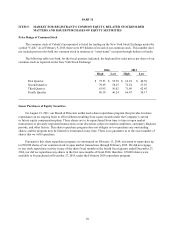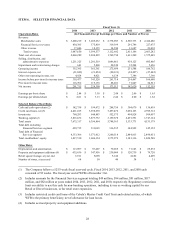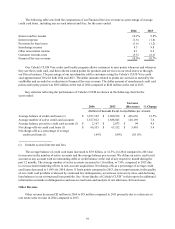Cabela's 2014 Annual Report Download - page 44
Download and view the complete annual report
Please find page 44 of the 2014 Cabela's annual report below. You can navigate through the pages in the report by either clicking on the pages listed below, or by using the keyword search tool below to find specific information within the annual report.34
On July 9, 2013, the FDIC adopted interim final rules which revised its risk-based and leverage capital
requirements for FDIC-supervised institutions. These interim final rules are substantially identical to the joint
final rules issued by the Office of the Comptroller of the Currency and the Board of Governors of the Federal
Reserve System on July 2, 2013. The interim final rules and the joint final rules implement the regulatory capital
reforms recommended by the Basel Committee on Banking Supervision in December 2010, commonly referred to
as “Basel III,” and capital reforms required by the Dodd-Frank Wall Street Reform and Consumer Protection Act
(the “Reform Act”). Among other things, the interim final rules and the joint final rules revise the agencies’ prompt
corrective action framework by introducing a common equity tier 1 capital requirement and a higher minimum
tier 1 capital requirement. In addition, the interim final rules and the joint final rules include a supplementary
leverage ratio for depository institutions subject to the advanced approaches capital rules. The phase-in period
for the interim final rules began in January 2015 for WFB. WFB has assessed how the interim final rules and the
joint final rules will impact it and its ability to comply with the new common equity tier 1 capital requirement and
higher minimum tier 1 capital requirement and has concluded that the impact will be minimal.
Also, in response to certain liquidity requirements under Basel III, the noteholders under one of the variable
funding facilities issued under WFB’s securitization program have requested and obtained amendments to their
respective transaction documents permitting them to delay funding an advance requested under that facility for up
to 35 days. It is not currently known what, if any, changes to their respective transaction documents the noteholders
under the other variable funding facilities issued under WFB’s securitization program will request in response to
the Basel III liquidity requirements. These changes could delay or disrupt access to funding under the variable
funding facilities. Moreover, the liquidity requirements under Basel III could result in an increase in the borrowing
costs under the variable funding facilities.
The Reform Act was signed into law in July 2010 and has made extensive changes to the laws regulating
financial services firms and credit rating agencies and requires significant rule-making. The changes resulting
from the Reform Act may impact our profitability, require changes to certain Financial Services segment
business practices, impose upon the Financial Services segment more stringent capital, liquidity, and leverage
ratio requirements, increase FDIC deposit insurance premiums, or otherwise adversely affect the Financial
Services segment’s business. These changes may also require the Financial Services segment to invest significant
management attention and resources to evaluate and make necessary changes.
The Reform Act also established the Consumer Financial Protection Bureau (the “Bureau”) within the
Federal Reserve, a new federal consumer protection regulator. The Bureau has broad rulemaking and enforcement
authority over providers of credit, savings, and payment services and products, and WFB is subject to its
regulation. While the Bureau does not currently examine WFB, it receives information from the FDIC, WFB’s
primary regulator. The Bureau also has rulemaking and interpretive authority under existing and future consumer
financial services laws and supervisory, examination, and enforcement authority over institutions subject to its
jurisdiction. The Bureau is specifically authorized to issue rules identifying as unlawful acts or practices it defines
as “unfair, deceptive or abusive acts” in connection with any transaction with a consumer or in connection with a
consumer financial product or service.
The Bureau, the FDIC, and other agencies have recently announced several high-profile enforcement actions
against credit card issuers for deceptive marketing and other illegal practices related to the advertising of ancillary
products, collection practices, and other matters. By these recent public enforcement actions, the Bureau and
the FDIC have signaled a heightened scrutiny of credit card issuers. Across the industry, we anticipate increased
activity by regulators in pursuing consumer protection claims going forward.
Several rules and regulations have been proposed or adopted that may substantially affect issuers of
asset-backed securities.
On December 10, 2013, the Federal Reserve, the Office of the Comptroller of the Currency, the FDIC, and
the Securities and Exchange Commission (“SEC”) approved joint final regulations implementing the provisions
of the Reform Act commonly referred to as the “Volcker Rule.” Generally, the Volcker Rule and the implementing
regulations prohibit any banking entity from engaging in proprietary trading and from investing in, sponsoring, or
























